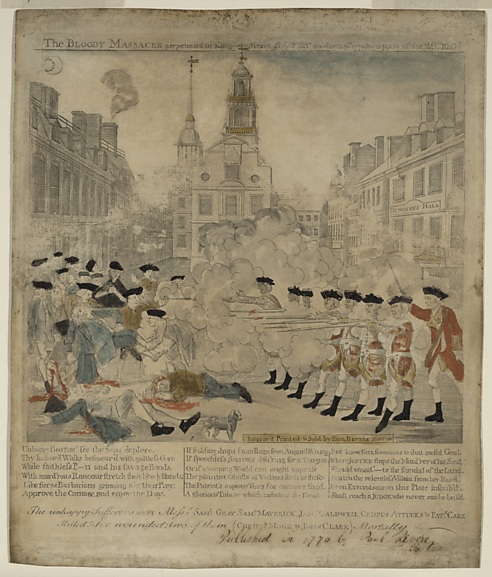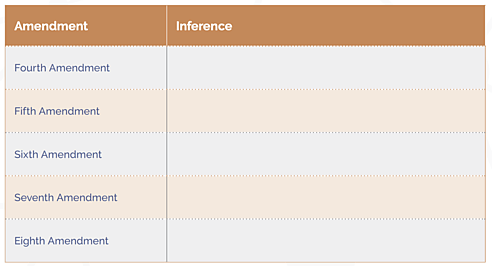Overview
In this lesson, students will identify the criminal procedure amendments of the Bill of Rights and discuss their significance in safeguarding civil rights and liberties.
In this lesson, students will identify the criminal procedure amendments of the Bill of Rights and discuss their significance in safeguarding civil rights and liberties.

Figure 1: Illustration of the Boston Massacre of 1770 by British Soldiers. Engraved, Printed and Sold by Paul Revere. loc.gov/item/2008661777/
Step 1: Define the difference between civil rights and liberties.
Step 2: Explain to students that they will be reading through the Fourth, Fifth, Sixth, Seventh, and Eighth Amendments.
Step 3: Have students with a partner complete the table in Handout 1. Ask them to read, discuss, and make inferences about what the amendments mean in the context of civil rights and liberties.
Step 4: In a whole group discussion, ask students to report back what they understand about the amendments. Display the table on the board and highlight the points that students make about each. Ask students to delve deeper into what the amendments have in common. Explain that they are each about criminal procedure. Share that this is a foundational piece of our founding documents and how criminal proceedings function through present day.
Step 1: Have students recall the Revolutionary War. Ask them to describe some of the factors that they recall contributed to why the colonists wanted to separate from England.
Step 2: Share that they will be circling back to the Boston Massacre, which took place March 5, 1770. Have students review the event as a class using the National Park’s “250th Anniversary of the Boston Massacre” Webpage
Step 3: As a class, discuss the event and how it might have played a factor in influencing how future president John Adams would see criminal procedure playing a role in the Bill of Rights.
Step 1: Have students in groups read the primary source, “Adams’ Argument for the Defense 3–4 December 1770.”
Step 2: Ask students to discuss how Adams viewed criminal procedure.
Step 3: Have students share and engage in class discussion. Share that in the Declaration of Independence, Thomas Jefferson makes indirect reference to the popular understanding of the Crown’s interference through mock trials, protecting large bodies of quartered troops “from punishment for any Murders which they should commit on the Inhabitants of these States.” Adams, by contrast, in his opening statement, reminds us of the “temper with which the law requires we should proceed to trial.” Have students expand on how they interpret the meaning of this quote. How does it fit into the larger context of the criminal procedure amendments they read about in the warm‐up?
Step 1: Share with students that the underpinnings of the Declaration of Independence and Constitution reflect the philosophical beliefs of individuals such as John Locke, who proposed ideas such as the social contract that held the belief that citizens should follow the law if the natural rights of each citizen, including their property, are protected.
Step 2: Define due process for students. Have students turn back to their handout from the warm‐up to review the amendments. Share that the Fifth Amendment in particular highlights that the federal government cannot deprive anyone of “life, liberty or property without due process of law.”
Step 3: Ask students to consider what the significance of due process under the law is in protecting civil rights and liberties of citizens. Have students turn and talk with a partner.
Step 4: On finishing discussing with their partners, have students return to a whole class discussion. Ask students to share their thoughts.
Step 5: Engage students in discussion about the right to due process and the broader criminal procedure outlined in the Bill of Rights:
Step 6: Describe to students that all the statutes did not apply to everyone—in particular, women, indigenous populations, and enslaved African Americans. Share that it would not be until the Reconstruction era that new amendments would be added to preserve the right to due process for all citizens. This would be challenged well into the next century, specifically during the civil rights movement, and will be a core element through the rest of this unit as we explore how criminal procedure amendments are intended to safeguard civil rights and liberties.
